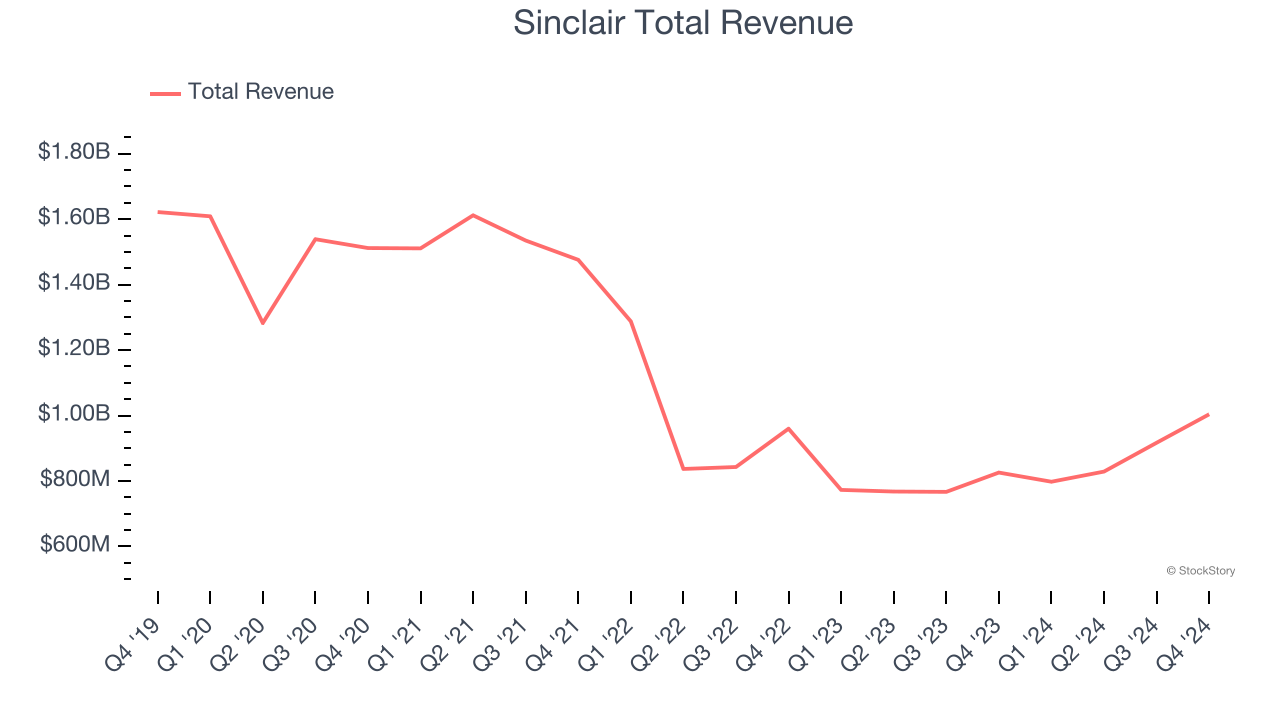
Looking back on traditional media & publishing stocks’ Q4 earnings, we examine this quarter’s best and worst performers, including Sinclair (NASDAQ:SBGI) and its peers.
The sector faces structural headwinds from declining linear TV viewership, shifts in advertising spend toward digital platforms, and ongoing challenges in monetizing print and broadcast content. However, for companies that invest wisely, tailwinds can include AI, the power of which can result in more personalized content creation and more detailed audience analysis. These can create a flywheel of success where one feeds into the other. Still there are outstanding questions around AI-generated content oversight, and the regulatory framework around this could evolve in unseen ways over the next few years.
The 4 traditional media & publishing stocks we track reported a satisfactory Q4. As a group, revenues missed analysts’ consensus estimates by 2.4% while next quarter’s revenue guidance was 0.7% below.
Amidst this news, share prices of the companies have had a rough stretch. On average, they are down 8% since the latest earnings results.
Sinclair (NASDAQ:SBGI)
With over 2,400 hours of local news produced weekly and 640 broadcast channels reaching millions of American homes, Sinclair (NASDAQ:SBGI) operates a network of 185 local television stations across 86 U.S. markets, producing news programming and distributing content from major networks.
Sinclair reported revenues of $1.00 billion, up 21.5% year on year. This print was in line with analysts’ expectations, and overall, it was a strong quarter for the company with an impressive beat of analysts’ EPS estimates.
“We are pleased to close out a strong 2024 and we have entered 2025 on a high note. Our consolidated Adjusted EBITDA for the fourth quarter exceeded our guidance range, along with various other key financial metrics. This performance underscores the continued dominance of broadcast TV as the leading platform for advertisers to reach broad audiences,” said Chris Ripley, Sinclair’s President and Chief Executive Officer.

Sinclair achieved the fastest revenue growth of the whole group. Investor expectations, however, were likely higher than Wall Street’s published projections, leaving some wishing for even better results (analysts’ consensus estimates are those published by big banks and advisory firms, not the investors who make buy and sell decisions). The stock is down 2.3% since reporting and currently trades at $14.14.
Is now the time to buy Sinclair? Access our full analysis of the earnings results here, it’s free.
Best Q4: EchoStar (NASDAQ:SATS)
Following its 2023 acquisition of DISH Network, EchoStar (NASDAQ:SATS) provides satellite communications, pay-TV services, wireless networks, and broadband solutions across consumer and enterprise markets.
EchoStar reported revenues of $3.97 billion, down 4.7% year on year, outperforming analysts’ expectations by 1.1%. The business had an exceptional quarter with a solid beat of analysts’ EPS estimates.
EchoStar pulled off the biggest analyst estimates beat among its peers. Although it had a fine quarter compared its peers, the market seems unhappy with the results as the stock is down 25% since reporting. It currently trades at $21.75.
Is now the time to buy EchoStar? Access our full analysis of the earnings results here, it’s free.
Weakest Q4: IMAX (NYSE:IMAX)
Originally developed for World Expo '67 in Montreal as an innovative projection system, IMAX (NYSE:IMAX) provides proprietary large-format cinema technology and systems that deliver immersive movie experiences with enhanced image quality and sound.
IMAX reported revenues of $92.67 million, up 7.7% year on year, falling short of analysts’ expectations by 11.1%. It was a disappointing quarter as it posted a significant miss of analysts’ EPS estimates.
IMAX delivered the weakest performance against analyst estimates in the group. As expected, the stock is down 17.6% since the results and currently trades at $22.45.
Read our full analysis of IMAX’s results here.
Wiley (NYSE:WLY)
With roots dating back to 1807 when Charles Wiley opened a small printing shop in Manhattan, John Wiley & Sons (NYSE:WLY) is a global academic publisher that provides scientific journals, books, digital courseware, and knowledge solutions for researchers, students, and professionals.
Wiley reported revenues of $404.6 million, down 12.2% year on year. This print topped analysts’ expectations by 0.9%. Overall, it was a very strong quarter as it also put up an impressive beat of analysts’ EPS estimates and a solid beat of analysts’ full-year EPS guidance estimates.
Wiley had the slowest revenue growth among its peers. The stock is up 12.9% since reporting and currently trades at $42.85.
Read our full, actionable report on Wiley here, it’s free.
Market Update
Thanks to the Fed’s rate hikes in 2022 and 2023, inflation has been on a steady path downward, easing back toward that 2% sweet spot. Fortunately (miraculously to some), all this tightening didn’t send the economy tumbling into a recession, so here we are, cautiously celebrating a soft landing. The cherry on top? Recent rate cuts (half a point in September 2024, a quarter in November) have propped up markets, especially after Trump’s November win lit a fire under major indices and sent them to all-time highs. However, there’s still plenty to ponder — tariffs, corporate tax cuts, and what 2025 might hold for the economy.
Want to invest in winners with rock-solid fundamentals? Check out our Top 5 Quality Compounder Stocks and add them to your watchlist. These companies are poised for growth regardless of the political or macroeconomic climate.
Join Paid Stock Investor Research
Help us make StockStory more helpful to investors like yourself. Join our paid user research session and receive a $50 Amazon gift card for your opinions. Sign up here.
